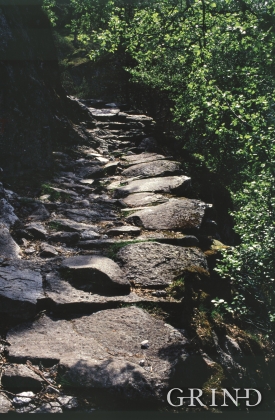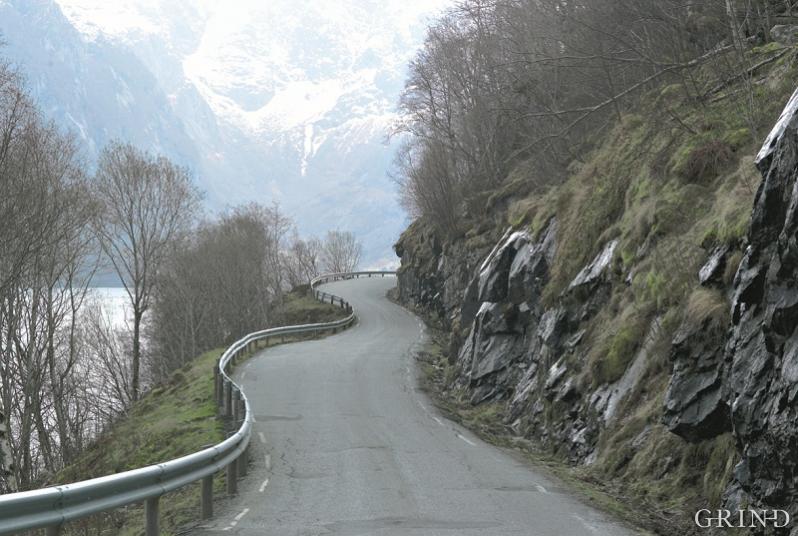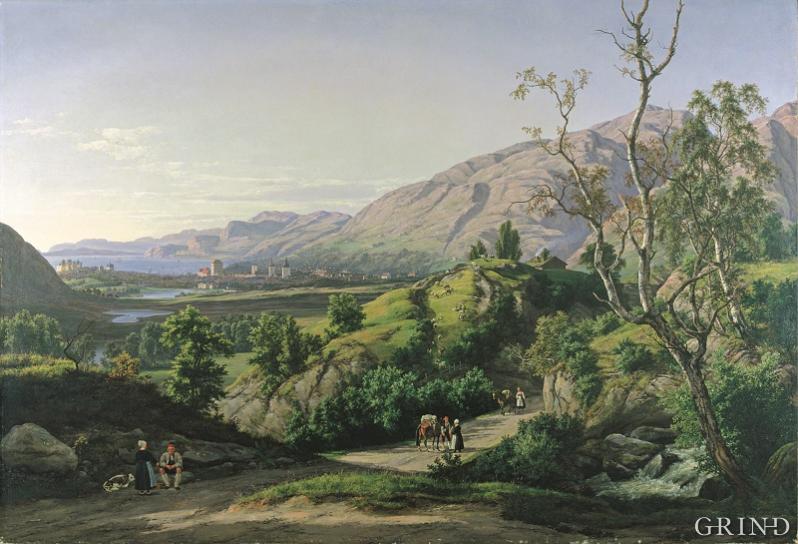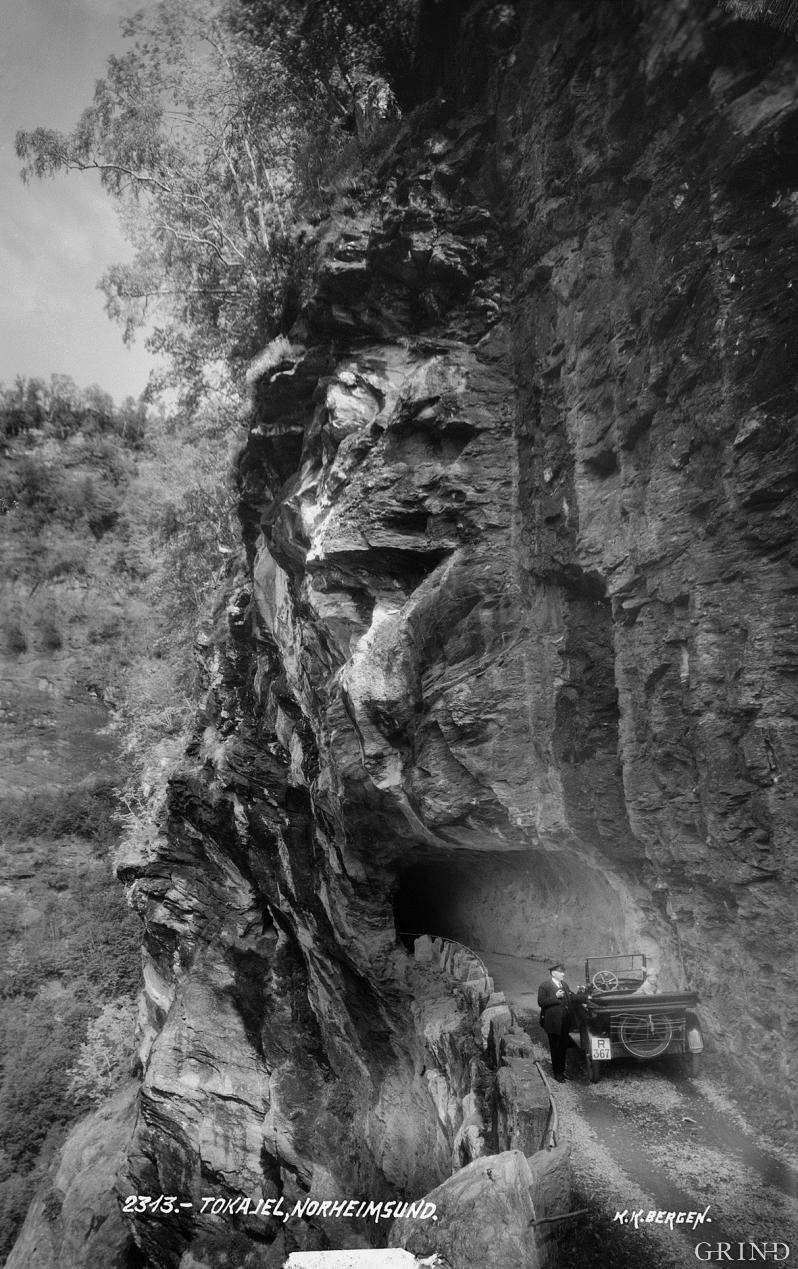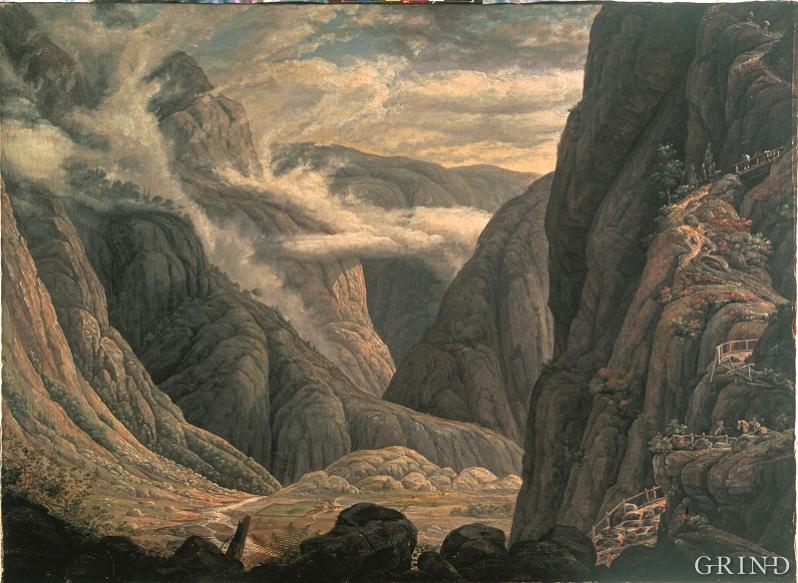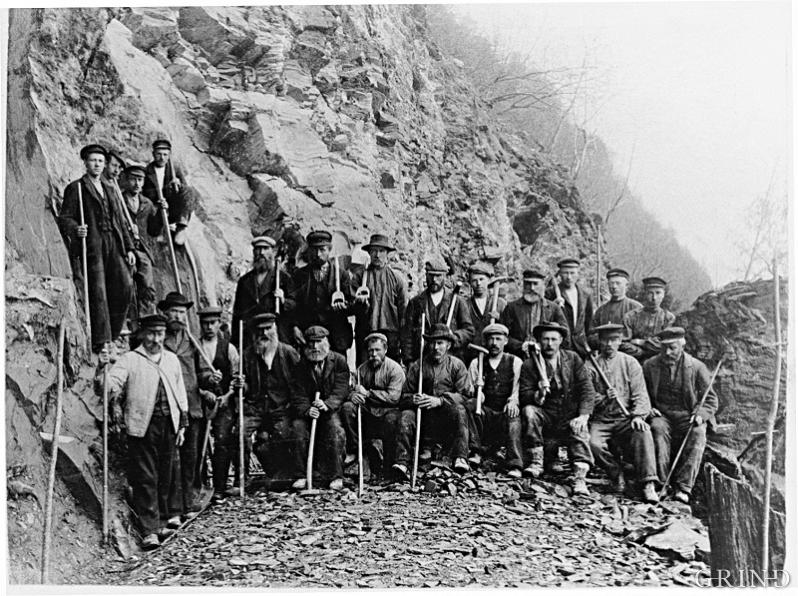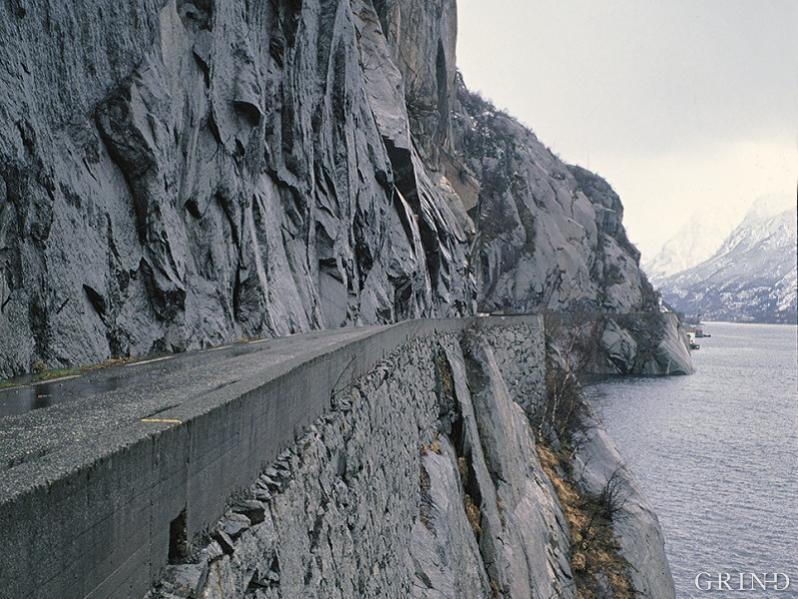Published: 19.05.2009 | Author: Johannes Gjerdåker
The road through Husedalen, from Kinsarvik up on to the Hardangervidda plateau is one of the old roads which give us an idea of how the “spearways” of the Middle Ages were. (Helge Sunde).
1. “SPEARWAY (public road), tracks to the mountain pasture and cattle tracks shall remain as they were from ancient time). 2.When the spearway runs across a man’s property, he can lead that road outside his property on the condition that he builds a new road off his property as long as people can travel in dry or wet weather, then people can use that road even if it is longer. 3. Now the spearway shall be so wide that a man sitting on a saddled horse puts a spear shaft down on the ground and reaches with the tip up to the shaft holder, and the spear shall be one span long from there and up, and that you should put across the road and the road should not be broader than this. But if anyone should further spoil the meadow or the cornfield he should repair the damage.”
This is how the Gulating Law expresses itself in Knut Robberstad’s sonorous translation. An adult man should have been able to ride along the country roads with a spear slung crosswise and willow rings hanging on the ends, without these rings catching on the branches on the side. Then the road was wide enough.
No farm or croft in Hordaland in historical times has lain more than one day’s journey on foot or horseback from the nearest fjord. It was no further from the highest point in Eksingdalen or Myrkdalen and Raundalen, nor from Røldal. All parishes in Hordaland had access to the sea within their boundaries. The division into coastal administrative districts was therefore practical for all the rural districts in the county.
In this landscape building roads at any time has been a demanding exercise, and it was an impossibility to build the majority of the roads which today are county roads or national highways until modern times. Even in Bergen, one of the biggest cities in Scandinavia for many centuries, had as late as 1930 no more than 30 kilometres of road altogether out of the town in any direction. But there have been roads and paths as long as people have lived here in this country.
The old travelling routes between different parts of the country
From prehistoric times the main travel routes between eastern and western Norway went over Langfjella, but it was only possible to cross from Lærdal and Røldal in the winter months. The mountain crossing between Lærdal and Valdres was the one that was most in use between Gulating and Eidsivating, and between Bjørgvin and Oslo after these towns were established in the 11th century. The traffic across Fillefjell mountain was so great that King Øystein had Maristova built about 1100 AD, and it was here that Thomas Church was built in the High Middle Ages.
When the Norwegian postal services were established in 1647 under King Christian IV, the important post route between Bergen and Christiania (as Oslo was known until 1925)2 was directed over Fillefjell Mountain. The post went by boat from Lærdal by way of Frønningen to Gudvangen and then by land via Stalheim, Oppheim, Vossevangen and Bolstadøyri and on through Tysso to Dalseid and Dale. They usually travelled from Bolstadøyri to Dalseid by boat and always out the fjord from Stanghelle to Tunes. From Tunes the post went through indre Arna and Borgo. Up Borgaskaret and so down into the city from there. No new post route was built in 1647, nor in the next hundred years after that. The post route followed the ancient travel route between Bergen and eastern Norway.
The Trondheim and Stavanger post roads
From the 1780s a postal service was also established between Bergen and Trondheim, and between Bergen and Stavanger. These postal routes were also confined as much as possible to the land. The route from Bergen to Trondheim went via Sandviken, Munkebotn, Glaskaret and Rolland in Åsane to Hordvik. From Hordvik the post went on by boat to Isdalstø. From Isdalstø the post route went through Seim and Lotrebogane, with a brief boat trip across Rydlandsvågen to Timbervik in Hundvinlandet. The next stage was the road from Lindås to Fannebost on Fensfjorden where the farmer postman rowed over by boat to Halsvik, right on the county boundary.
The postal route to Stavanger went via Midttun across Vallaheiane with a change of horses at Kyrkebyrkeland, to Sandven and Søfteland and on to Os with a change of horses in Hatvik. From there the route went by boat over to Fusa. Then from the post farm Øpstad the route went over Fusafjellet to Strandvik. Then followed a long stage on the fjord to Sundfjord in Lygrepollen. The stretch from Sundfjord to Husa in Ølve was one more short stage on land. Here a post-opening office at Roaldtveit was built in 1859. From Husa the post went on across the fjord to Skånevik. From Leknes in Skånevik the post went across the mountains to Silde in Etne and from Etne via Ølen to Sandeid in Rogaland County. The total length of post roads in Hordaland County was 216 kilometres.
In the years from 1750 onwards, postal inspector Schanke did a great job to plan better and quicker postal despatch in the whole country. He cooperated with the Chief Roads Officer von Krogh. They prepared for a bigger modernisation of the roads, with new walls, roads and postal quays. And in Hordaland too a lot of construction work was done on the roads. Especially in the years from 1780 to 1804. In effect this was the first major roadworks which had been started in western Norway since the Middle Ages.
The reason for the work was the rapid economic growth and population increase in Norway in this time, with more trade and a more differentiated business life which made new demands for a faster and more secure postal services between the big towns. It was still only letters which were sent, and most of it was sent on official business. From 1804 onwards there were two consignments of mail each week between Kristiania (Oslo) and Bergen. During the previous 150 years from 1647, there had only been one consignment a week.
Vehicular roads and carriages
The road inspectors and those who planned the roads in those days were captains in the Army. These were still the only people who had training in surveying and levelling. In the period 1780-1820 the post was carried on horseback - or on a human back - during summer, and by sled in winter. Wheeled transport had not come into use at all of western Norway yet, but it is clear that the road sections which were designed and built in the period from 1780 up until the Napoleonic Wars were planned as vehicular roads. In other words the builders were far-sighted enough to see carts and carriages would also come into use here. Not only western Norway but the whole of Norway got going very late with building vehicular roads. The road between Kongsberg and Drammen which King Christian IV prepared for in 1625, was, for a long time, the only one of its type.
In 1824 Norway got a new Roads Law. Under this all roads were given the status of either a main road or a rural road. The law regarded all international roads, roads between different parts of the country and roads into cities as main roads. The Road Law mentioned church roads and council roads in particular as being rural roads. The Road Law states that the costs of building or diverting a main road should usually be paid by the county through which the road went.
The road law and local self-government
The economic strength of the country and the county was still weak and no major road project was started up between 1824 and 1840. The first County Council, after the introduction of the executive committee laws in 1837, resolved in 1838 that the road from Eide in Granvin to Vossevangen should be the main road, and that the costs of the construction and maintenance should be borne by the County. The reason for this resolution was that this stretch of road was the only one from Hardanger to Bergen. The resolution was an important one of principle. And with this resolution the County Council introduced road construction and transport issues on to its programme.
In the 1840s the Storting (the Norwegian national Parliament) approved the building of a road facility in Stalheimskleiva, in connection with the modernisation of the postal route from Christiania to Bergen. The national government bore the whole cost, and the facility was officially opened in 1849. From that time on Stalheimskleiva has maintained the form with which we are familiar today. The changes have been small in comparison with the large dimensions of the works undertaken in the 1840s.
Otherwise it was the stretches from Stalheim via Voss and to Eide in Granvin that the national government and the county did most for in the 1850s and 1860s. The whole of the road from Gudvangen to the Hardanger Fjord in Granvin was open for traffic with carriages in 1866. The reason that other parts of the county did not get road facilities during that period is that from the years after 1850 there was a great increase in the new steamship routes. Steamship traffic fired local interests and the commercial tourism which was starting up. Thomas Cook’s travel agency in London from the time around 1885 sold the first package tours to western Norway with payment by coupons for hotels, steamship routes and coaching stations along the roads. A popular route went from Ryfylke to Hardanger by steamship and went thereafter over land from Granvin to Vossevangen and Gudvangen and on by boat to Bergen.
But what bought out local road building was the steamship routes and the railway which provided quicker connections to the city than before.
The road and the railway
The Voss Railway was approved by the Storting, and the project got started in 1876. As we know from Norwegian history the decision was the result of a compromise. Bergen and the region had worked for a rail connection over the mountains from Bergen to Oslo, but the Storting could not agree on more than the stretch from Bergen to Voss. Those whose objective was to get a railway on to Oslo, saw the Voss Railway as part of a greater whole and worked with plans to extend it. However the years 1876 to 1890 were difficult ones. After the Voss Railway was completed in 1883, no new Norwegian railway was started before 1894. Then the Storting resolved to build the railway line from Voss to Taugavatn in the high mountains. After that came the decision to extend the railway from Taugavatn (Finse) to Hønefoss and Roa-Oslo. The Bergen Railway (from Bergen to Oslo) was completed in 1909.
For Bergen and Hordaland, the railway connection had immense economic and cultural significance, perhaps especially for the rural districts in the northeast of the county. When the Voss railway was completed, work was begun on a road system which would link side valleys and mountain farms to the railway. The roads from Trengereid to Samnanger, from Dale to Bergsdalen, from Evanger to Brekkhus-Århus in Teigdalen, from Bulken to Viki and Dalane in Voss, with a bridge over Lilandsosen from 1885 from Revke to Giljarhus in Dyrvedalen - all these roads were started on in the period 1879-1886, in order to provide a road link to the Voss railway. And we should view the County Council resolution from 1881 for a new road from Eidslandet to Lavik in Eksingdalen, in the light of the Bergen-Voss railway. From Lavik and further up towards Upper Eksingdalen a vehicular road was built in the years from 1905 up to 1940.
Bergen – The big market
The new road connections had the effect that Bergen came much nearer. Previously the farmers had delivered cheese and butter to the city, twice a year, in June and October. Then they had a strenuous climb down from the mountains to the fjord and a long trip by rowing boat to Bergen behind them. The drovers had driven living cattle on the ancient drove roads across the mountains from Voss and Evanger through Bergsdalen to Samnanger and further on across Gullfjellet to Fana and Natland and to Bergen. Now the farmers got together in individual rural associations for building dairies and with direct supplies to Bergen. In Evanger, mostly in Teigland, the farmers occupied themselves a lot with meat processing. This activity could be increased considerably when the railway connection and the vehicular road to the railway station were opened.
The construction of the Bergen Railway in the years from 1896 to 1906 when the line was opened for operations from Voss to Myrdal, also gave rise to increased road building. A new road from Palmafossen to Uppsete at Gravahalsen was the first to be built, before transport to the site could begin. On the east side of Gravahalsen a road was built at the same time from Flåm to Myrdal and on to Hallingskeid and Taugavatnet-Finse. This road was also built for construction traffic for the Bergen Railway. In our own time the construction roads run across the mountains from Raundalen through Myrdal-Hallingskeid-Finse to Haugastøl providing a fine tourist road in summer for either bicycling or hiking.
The roads out of Bergen
After the 1780s Bergen had roads to Garnes, Hordvik and Os. None of these roads were more than 30 kilometres long. It was to take almost 150n years before interest for road construction was to become serious, when car traffic took off after 1900.
From 1901 to 1908 people in Haus rural municipality built a road between Garnes and Tunes. Here the Tunes-Trengereid stretch still remained unbuilt, before one came into the continuous vehicular road from Trengerid-Tysse in Samnanger-Kvamskogen-Tokagjelet-Norheimsund-Øystese. The road from Tysse across Kvamskogen to Norheimsund had received allocations from the county budget from 1885 onwards. A continuous road from Trengereid to Fyksesundet was completed in 1907. Here there had been no one major road, but many smaller, local roads which were gradually joined up in the period 1860 to 1907. The county had covered 20% of the cost, but Samnanger and Kvam had contributed the most. From 1907 onwards one could drive from Bergen to Norheimsund in 9 hours; the first one and a half hours by train to Trengereid and then seven and a half hours by horse and carriage from there.
Ferries and bridges – A new area
The road between Tunes and Trengereid was first completed in 1932. It took such a long time because Bergen Municipality strove for many years for a road connection eastwards along the route of the old military road from Haugsdal in Fana to Hisdalen in Samnanger. Bergen put aside money for this project, and in the County Council there were also many who voted for it. But through its employment creation projects during the 1920s Haus rural municipality did so much work on the Tunes-Trengereid road that in 1927 Bergen municipality chose this alternative for the eastward road connection to the outside world. Now Bergen and the State granted funds to this road to get it moving, and in 1933 the newly established Bergen-Hardanger Bus Company could start operating. From 1st July in that year they operated 4 buses with a total of 50 seats on the route between Bergen and Norheimsund.
The construction work on the road between Øystese and Granvin began in 1933, and on the 9th October 1937 the Fyksesund Bridge was opened. On the stretch of road between Øystese and Fykse the road authorities experience “Norway’s longest strike”. Work was suspended for almost a year from 1933 to 1934. The most difficult portion along the Hardanger Fjord was part of the stretch between Ålvik and Kvanndal. Here the road lies in several places on a smooth bare rock face, carved out of the rock. The last part of the road Bergen-Kvam-Granvin-Voss was the portion between Kvanndal and Granvin. Here the road was completed in 1941. So that vehicular traffic could get the best use of the roads, the Hardanger road from Bergen had to be linked with the road on the south side of Hardanger Fjord with regular car ferry services. From as early as 1933 the car ferry between Norheimsund-Øystese on the north side and Ringøy-Eidfjord on the south side had been established. At the beginning the boats took the cars on board using a crane. From 1936 the car ferry, now with the opportunity to drive the cars on board, ran between Øystese and Kinsarvik when the road between Eidfjord and Kinsarvik was completed, and later between Ålvik and Kinsarvik.
Links with the outside world
From the 1840s the road through Voss and Stalheim to Gudvangen with connections on to Lærdal and over Fillefjell mountain to Oslo, was the only road link for 40 years, from Hordaland County eastwards. But even at that time, at the initiative of Nils Hertzberg, the rural dean in Ullensvang, there was work to get a main highway connection across the mountains from Sørfjorden through Røldal and into Telemark County. The Storting began to grant funds for road construction here in 1857. The road from Odda to Røldal was built first. The state met all the construction costs of the road across Haukeli Mountain from Hordaland to Telemark County. The main highway Odda-Røldal-Telemark was completed in 1889. Shortly afterwards the road from Røldal through Brattlandsdalen to Suldal in Rogaland County was built; it was opened in 1892.
The road between Haugesund and inner Sunnhordland came in 1861, and between Haugesund and Tittelsnes peninsula in 1869-1874. In the 1890s a road was built between Ølen and Sandeid. The demanding stretch of road along Åkra Fjord was completed in 1942. Then Haugesund and inner Sunnhordland had a connection to Røldal-Telemark County and with Odda and Eidfjord. The road on the east side of Sørfjorden, through Tyssedal, Lofthus and Kinsarvik to Eidfjord was opened in 1936.
The construction of the road of the Hardangervidda plateau through Eidfjord and Haugastøl got started early in the 1920s and here the road was opened in 1932. The road up the steep Måbø valley (Måbødalen) is a masterpiece of the engineer’s art. As early as the 1930s work was in progress to get a road built between Vossestrand over the mountains to Vik in Sogn. Thanks to a great effort by the country folk on both sides of the Vika Mountain, the road was completed in the 1950s and the road was opened in 1957.
The newest connecting road with another county is the road from Knarvik across Ostereidet and Romarheim to Matre and Instefjord in Sogn, the Romarheim Road. This is a link in the outer national highway, National Highway No.1. But the first national highway from ancient times, is the sea passage along the coast.
And still there lie many of the Middle Ages’ country roads under today’s routes.
- Gjerdåker, J. (1986) Billag i rute: Bergen-Hardanger-Voss billag 1911-1986. Voss, [BHV].
- Strand, O. (1958) Hardangerveien og Hardangerbilene: utgitt i anledning av Bergen-Hardanger billag A.S 25 års jubileum 22.6-1958. [Bergen], [BHV].
- Sølvberg, I. Ø. (1974) Gamle "byveger" til Bergen. I: Skrifter (Bergens historiske forening). Bergen, Bergens historiske forening, nr. 74, s. 203-218.

